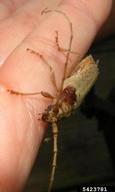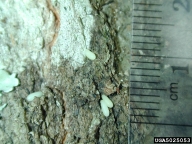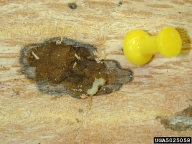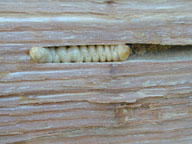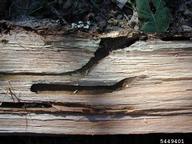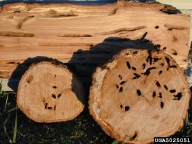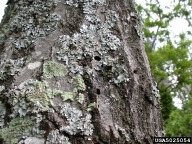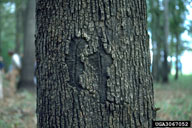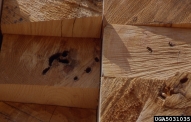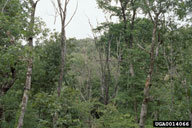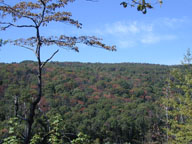Red oak borer
Enaphalodes rufulus (Haldeman) (Coleoptera: Cerambycidae)
Orientation to pest
Red oak borer, Enaphalodes rufulus (Haldeman), is a native borer to North America, which attacks various species of oak (Quercus), primarily those in the red oak subgenus. Red oak borer has a 2-year life cycle that is unique in that adults only emerge during odd numbered years. Mating takes place on the host tree and females lay eggs in midsummer on roughened areas or near wounds, in bark crevices, or under lichen or vines. Young larvae bore through the bark and spend their first year in the phloem making small tunnels. The 2-year-old larvae enlarge these phloem galleries and then bore into the xylem where pupation takes place. The adult eventually emerges near the original oviposition site. Fine frass is one of the first signs of attack. As the larvae bore into the tree, wet spots can appear on the bark as sap oozes from the bore hole in the bark. Larval galleries increase in size over time, reaching 1.5 cm in diameter. Tunnels are 15 to 25 cm long and penetrate directly through the oak xylem. Larval tunnels cause lumber cut from infested logs to be downgraded, reducing log value by up to 40% compared to top quality wood.
Hosts commonly attacked
This species attacks various oaks, including black (Quercus velutina Lamb.), northern red (Quercus rubra L.), and scarlet (Quercus coccinea Muenchh.) oaks.
Distribution
Red oak borer is found throughout southern Canada and the eastern United States.
Images of red oak borer
| Figure 1. Adult of the red oak borer, Enaphalodes rufulus | Figure 2. Eggs of red oak borer | Figure 3. Young 1st-year red oak borer larva creating gallery in phloem | Figure 4. Late stage red oak borer larva in xylem gallery |
| Figure 5. Gallery of red oak borer | Figure 6. Galleries of older red oak borer larvae in the heart wood, seen in cross section | Figure 7. Emergence holes of red oak borer | Figure 8. Healed scars showing damage from red oak borer |
| Figure 9. Lumber cut from infested trees is downgraded because of the galleries of red oak borer | Figure 10. View of trees killed by red oak borer | Figure 11. View of red oaks killed in the Arkansas Ozarks during outbreak, September 2000 |
Important biological control agents related to this pest species
Parasitoids of this species are mostly generalists on wood borers and are not well known. Woodpeckers are an important predator of red oak borer larvae.
Web links for information on red oak borer
- Pest Alert List Entry | European & Mediterranean Plant Protection Organization
Fact sheet on risk of red oak borer as a potential risk for invasion to Europe
Articles
- Riggins, J. J., L. D. Galligan, and F. M. Stephen. 2009. Rise and fall of red oak borer (Coleoptera: Cerambycidae) in the Ozark mountains of Arkansas, USA. Florida Entomologist 92: 426-433.
- Haavik, L. J. and F. M. Stephen, F. M. 2010. Historical dynamics of a native cerambycid, Enaphalodes rufulus, in relation to climate in the Ozark and Ouachita Mountains of Arkansas. Ecological Entomology 35: 673-683.
